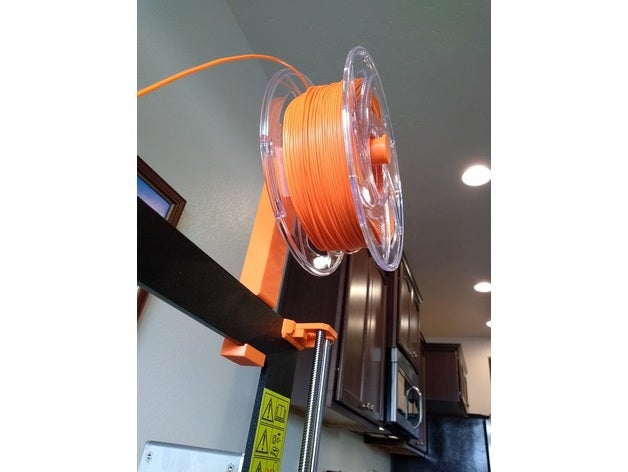Moisture control, addition friction
Hi Forum!
I am looking for a moisture control system for my filament, compatible with prusa 3s.
There are some commercial as well as DIY solutions out there. My concern is on the additional friction on the filament.
I have never understood why a so sophisticated device as a Prusa has such a crappy backend for filament delivery?
Why is there no proactive feeding of the roll to the printer?
And this concern deepens if I look at moisture controlled enclosements.
How do one get its filament mostly frictionless or active to the extruder?
Cheers,
Volker
RE: Moisture control, addition friction
You would be surprised at how much pull the extruder can exert. Early on when I was still using a stock, direct drive Prusa R3 extruder, a spool toppled over. It was on a spool holder atop the Lack enclosure. I walked into the room to find my printer half suspended. Only two feet were still touching. Half the printer was 10 cm lifted up. I doubt it would have lifted the entire printer completely into mid-air, but it was an impressive demonstration of how much force the extruder can pull.
RE: Moisture control, addition friction
@guy-k2
I am a Physicist. I know on pull. But I know also on accuracy. And both do not play well with each other.
In any 3D-Printer there is some slack. If there is no friction on the filament the slack is distributed statistically.
But if you impose some strain (like your GREAT PULL) on the extruder the slack gets directed - producing regular patterns.
Cheers,
Volker
RE: Moisture control, addition friction
[...] How do one get its filament mostly frictionless or active to the extruder?
Far from frictionless, but you might want to look into some of the "reverse bowden" setups as an interim solution. Basically, a PTFE tube from the spool to the extruder used to reduce friction and keep tension even at all times.
RE: Moisture control, addition friction
@bobstro
That is a real pointer!
Cheers,
Volker
RE: Moisture control, addition friction
I did a simpler trick to equalize tension: rotated the spool 90 degrees. Now the spool is aligned with the extruder path, no more side to side delta, not more forcing/torquing filament off the spool, just simple direct motions.
RE: Moisture control, addition friction
I did a simpler trick to equalize tension: rotated the spool 90 degrees. Now the spool is aligned with the extruder path, no more side to side delta, not more forcing/torquing filament off the spool, just simple direct motions.
Intriguing. I don't suppose you have a link for the model of this filament holder somewhere?
See my (limited) designs on:
Printables - https://www.printables.com/@Sembazuru
Thingiverse - https://www.thingiverse.com/Sembazuru/designs
RE: Moisture control, addition friction
I use a reverse bowden setup with capricorn tubing from the arm to the extruder. The cable rollers I sit my filament on have bearings and were too free rolling so the reels were unwinding when given a slight tug, so I ended up having to put felt under the rollers to actually give it some friction!.
There is some friction through the capricorn tubing due to it having a smaller inner diameter than most of the generic PTFE tubing used, but I see no difference between my original hung from above mounting arm and the reverse bowden type setup I use now.
(But saying that, I haven't tried running without the reverse bowden setup since my upgrades to extruder, and motors and firmware. - Another thing to try!)
The biggest difference with my current setup is that the whole printer frame does not shake as much as there is no longer a 1KG weight attached to it.
Normal people believe that if it ain’t broke, don’t fix it. Engineers believe that if it ain’t broke, it doesn’t have enough features yet.
RE: Moisture control, addition friction
First of all I wouldn't call Prusa printer a sophisticated device :).
The default solution has the advantage to be transportable and very inexpensive/works with most spools. If you want to have less friction and no weight on top of the printer, just remove the spool from the top and attach it to whatever your setup is. As Prusa printer is not boxed, everybody is using it in a different environment. So it's kind of natural to have your own solution for that.
Often linked posts:
Going small with MMU2
Real Multi Material
My prints on Instagram
RE: Moisture control, addition friction
ps: it is a work in progress, PLA worked for me, but the clamp is getting looser, though gravity is what keeps it all in place, so I keep using the original print.
RE: Moisture control, addition friction
ps: it is a work in progress, PLA worked for me, but the clamp is getting looser, though gravity is what keeps it all in place, so I keep using the original print.
Thanx for the model. I may try it in either nGen or PETG at some point and have one on either side (so I can have up to two spools ready for manual MMU printing). I'm thinking that printing on the side so the layer lines aren't the limiting factor holding the clip to the printer frame. And for the supports under the arm to try using your trick of zero interface layers and very tiny contact distance.
Not sure when I'll get to that though...
See my (limited) designs on:
Printables - https://www.printables.com/@Sembazuru
Thingiverse - https://www.thingiverse.com/Sembazuru/designs
RE: Moisture control, addition friction
I printed arm up - I was worried about strength, but turns out that was a don't care. It only holds 1.2 kg with heavy full spool. I think a more flexible material like PETG will help it stay clamped better. But I'd clip the clamp section and print a test piece to ensure PETG doesn't shrink too much. The fit was pretty tight when I made the part.
